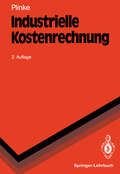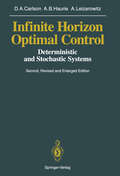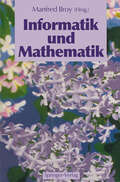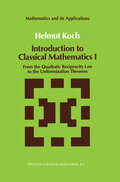- Table View
- List View
ICM-90 Satellite Conference Proceedings: Harmonic Analysis Proceedings of a Conference held in Sendai, Japan August 14–18, 1990
by Satoru IgariProceedings of a Conference held in Sendai, Japan, August 14-18, 1990
Identification of Continuous-Time Systems: Methodology and Computer Implementation (Intelligent Systems, Control and Automation: Science and Engineering #7)
by N. K. Sinha G. P. RaoIn view of the importance of system identification, the International Federation of Automatic Control (IFAC) and the International Federation of Operational Research Societies (IFORS) hold symposia on this topic every three years. Interest in continuous time approaches to system identification has been growing in recent years. This is evident from the fact that the of invited sessions on continuous time systems has increased from one in the 8th number Symposium that was held in Beijing in 1988 to three in the 9th Symposium in Budapest in 1991. It was during the 8th Symposium in August 1988 that the idea of bringing together important results on the topic of Identification of continuous time systems was conceived. Several distinguished colleagues, who were with us in Beijing at that time, encouraged us by promising on the spot to contribute to a comprehensive volume of collective work. Subsequently, we contacted colleagues all over the world, known for their work in this area, with a formal request to contribute to the proposed volume. The response was prompt and overwhelmingly encouraging. We sincerely thank all the authors for their valuable contributions covering various aspects of identification of continuous time systems.
Industrielle Kostenrechnung: Eine Einführung (Springer-Lehrbuch)
by Wulff PlinkeKostenbewußtes Denken und Handeln wird vom Ingenieur in der Praxis zunehmend gefordert. Ob er in der Konstruktion, Produktion oder im Vertrieb tätig ist, der Ingenieur muß in der Lage sein zu beurteilen, welche Kosteninformationen er für welche Entscheidungen benötigt, wie die Daten zu interpretieren sind und welche Konsequenzen er für das betriebliche Handeln daraus ziehen muß. Industrielle Kostenrechnung für Ingenieure bietet sowohl für den Ingenieurstudenten als auch für den im Beruf stehenden Ingenieur eine sichere Einführung in die Grundlagen und in die modernen Verfahren der industriellen Kostenrechnung. Didaktisch geschickt wird der Ingenieur mit den Elementen der Kostenrechnung vertraut gemacht. Für die Vorbereitung auf die Praxis des Ingenieurs sind die spezifischen Verfahren der Auftragskalkulation im industriellen Produkt- und Anlagengeschäft von besonderem Interesse. Das Buch hebt sich von anderen Lehrtexten vor allem durch eine klare Systematik der Verfahren der industriellen Kostenrechnung sowie durch eine an der Zielgruppe der Ingenieure orientierte Darstellung ab.
Inequalities Involving Functions and Their Integrals and Derivatives (Mathematics and its Applications #53)
by Dragoslav S. Mitrinovic J. Pecaric A.M FinkInfinite Horizon Optimal Control: Deterministic and Stochastic Systems
by Dean A. Carlson Alain B. Haurie Arie LeizarowitzThis monograph deals with various classes of deterministic and stochastic continuous time optimal control problems that are defined over unbounded time intervals. For these problems the performance criterion is described by an improper integral and it is possible that, when evaluated at a given admissible element, this criterion is unbounded. To cope with this divergence new optimality concepts, referred to here as overtaking optimality, weakly overtaking optimality, agreeable plans, etc. , have been proposed. The motivation for studying these problems arises primarily from the economic and biological sciences where models of this type arise naturally. Indeed, any bound placed on the time hori zon is artificial when one considers the evolution of the state of an economy or species. The responsibility for the introduction of this interesting class of problems rests with the economists who first studied them in the modeling of capital accumulation processes. Perhaps the earliest of these was F. Ramsey [152] who, in his seminal work on the theory of saving in 1928, considered a dynamic optimization model defined on an infinite time horizon. Briefly, this problem can be described as a Lagrange problem with unbounded time interval. The advent of modern control theory, particularly the formulation of the famous Maximum Principle of Pontryagin, has had a considerable impact on the treat ment of these models as well as optimization theory in general.
Information Dynamics (Nato Science Series B: #256)
by Harald Atmanspacher Herbert ScheingraberProceedings of a NATO ASI held in Irsee/Kaufbeuren, Germany, June 15--26, 1990
Informationsverarbeitung in der Robotik (Springer-Lehrbuch)
by Rüdiger Dillmann Martin HuckIn die Robotik fließen Beiträge zahlreicher Wissensgebiete aus Maschinenbau, Elektrotechnik und Informatik ein. In diesem Buch steht die Informationsverarbeitung im Vordergrund: Roboter in einer realen Umwelt sollen gestellte Aufgaben selbständig und korrekt ausführen sowie angemessen auf unvorhergesehene Ereignisse reagieren; dazu ist die Modellierung der realen Einsatzumgebung und eines intelligenten Systemverhaltens sowie kognitive und motorische Fähigkeiten erforderlich. Methoden der Künstlichen Intelligenz werden eingesetzt, um Signale - über Sensoren aus der physikalischen Umwelt gewonnen - zu verarbeiten bzw. zu interpretieren und somit Wirkzusammenhänge zwischen Aktion und Reaktion herzustellen. Das Buch stellt aus Sicht der Informationsverarbeitung Modelle, Steuerungs- und Sensorkonzepte sowie Programmierverfahren vor und weist auf Anwendungsmöglichkeiten und zukünftige Entwicklungen hin. Es wendet sich daher nicht nur an Studenten während der Ausbildung, sondern auch an den Praktiker, der sich mit den neuen Entwicklungen vertraut machen will.
Instabilities and Nonequilibrium Structures III (Mathematics and Its Applications #64)
by E. Tirapegui W. ZellerProceedings of the 3rd Workshop on Instabilities and Nonequilibrium Structures
Instantons and Four-Manifolds (Mathematical Sciences Research Institute Publications #1)
by Daniel S. Freed Karen K. UhlenbeckFrom the reviews of the first edition: "This book exposes the beautiful confluence of deep techniques and ideas from mathematical physics and the topological study of the differentiable structure of compact four-dimensional manifolds, compact spaces locally modeled on the world in which we live and operate... The book is filled with insightful remarks, proofs, and contributions that have never before appeared in print. For anyone attempting to understand the work of Donaldson and the applications of gauge theories to four-dimensional topology, the book is a must." #Science#1 "I would strongly advise the graduate student or working mathematician who wishes to learn the analytic aspects of this subject to begin with Freed and Uhlenbeck's book." #Bulletin of the American Mathematical Society#2
Interactive System Identification: Prospects and Pitfalls (Communications and Control Engineering)
by Torsten BohlinThe craft of designing mathematical models of dynamic objects offers a large number of methods to solve subproblems in the design, typically parameter estimation, order determination, validation, model reduc tion, analysis of identifiability, sensi tivi ty and accuracy. There is also a substantial amount of process identification software available. A typi cal 'identification package' consists of program modules that implement selections of solution methods, coordinated by supervising programs, communication, and presentation handling file administration, operator of results. It is to be run 'interactively', typically on a designer's 'work station' . However, it is generally not obvious how to do that. Using interactive identification packages necessarily leaves to the user to decide on quite a number of specifications, including which model structure to use, which subproblems to be solved in each particular case, and in what or der. The designer is faced with the task of setting up cases on the work station, based on apriori knowledge about the actual physical object, the experiment conditions, and the purpose of the identification. In doing so, he/she will have to cope with two basic difficulties: 1) The com puter will be unable to solve most of the tentative identification cases, so the latter will first have to be form11lated in a way the computer can handle, and, worse, 2) even in cases where the computer can actually produce a model, the latter will not necessarily be valid for the intended purpose.
International Symposium in Memory of Hua Loo Keng: Volume I Number Theory
by Sheng Gong Qi-Keng Lu Yuan Wang Lo YangIntersections of Random Walks (Probability and Its Applications)
by Gregory F. LawlerA more accurate title for this book would be "Problems dealing with the non-intersection of paths of random walks. " These include: harmonic measure, which can be considered as a problem of nonintersection of a random walk with a fixed set; the probability that the paths of independent random walks do not intersect; and self-avoiding walks, i. e. , random walks which have no self-intersections. The prerequisite is a standard measure theoretic course in probability including martingales and Brownian motion. The first chapter develops the facts about simple random walk that will be needed. The discussion is self-contained although some previous expo sure to random walks would be helpful. Many of the results are standard, and I have made borrowed from a number of sources, especially the ex cellent book of Spitzer [65]. For the sake of simplicity I have restricted the discussion to simple random walk. Of course, many of the results hold equally well for more general walks. For example, the local central limit theorem can be proved for any random walk whose increments have mean zero and finite variance. Some of the later results, especially in Section 1. 7, have not been proved for very general classes of walks. The proofs here rely heavily on the fact that the increments of simple random walk are bounded and symmetric.
Intersections of Random Walks (Probability and Its Applications)
by Gregory F. LawlerA more accurate title for this book would be "Problems dealing with the non-intersection of paths of random walks. " These include: harmonic measure, which can be considered as a problem of nonintersection of a random walk with a fixed set; the probability that the paths of independent random walks do not intersect; and self-avoiding walks, i. e. , random walks which have no self-intersections. The prerequisite is a standard measure theoretic course in probability including martingales and Brownian motion. The first chapter develops the facts about simple random walk that will be needed. The discussion is self-contained although some previous expo sure to random walks would be helpful. Many of the results are standard, and I have made borrowed from a number of sources, especially the ex cellent book of Spitzer [65]. For the sake of simplicity I have restricted the discussion to simple random walk. Of course, many of the results hold equally well for more general walks. For example, the local central limit theorem can be proved for any random walk whose increments have mean zero and finite variance. Some of the later results, especially in Section 1. 7, have not been proved for very general classes of walks. The proofs here rely heavily on the fact that the increments of simple random walk are bounded and symmetric.
Introduction to Classical Mathematics I: From the Quadratic Reciprocity Law to the Uniformization Theorem (Mathematics and Its Applications #70)
by Helmut KochIntroduction to Complex Analytic Geometry
by Stanislaw Lojasiewiczfacts. An elementary acquaintance with topology, algebra, and analysis (in cluding the notion of a manifold) is sufficient as far as the understanding of this book is concerned. All the necessary properties and theorems have been gathered in the preliminary chapters -either with proofs or with references to standard and elementary textbooks. The first chapter of the book is devoted to a study of the rings Oa of holomorphic functions. The notions of analytic sets and germs are introduced in the second chapter. Its aim is to present elementary properties of these objects, also in connection with ideals of the rings Oa. The case of principal germs (§5) and one-dimensional germs (Puiseux theorem, §6) are treated separately. The main step towards understanding of the local structure of analytic sets is Ruckert's descriptive lemma proved in Chapter III. Among its conse quences is the important Hilbert Nullstellensatz (§4). In the fourth chapter, a study of local structure (normal triples, § 1) is followed by an exposition of the basic properties of analytic sets. The latter includes theorems on the set of singular points, irreducibility, and decom position into irreducible branches (§2). The role played by the ring 0 A of an analytic germ is shown (§4). Then, the Remmert-Stein theorem on re movable singularities is proved (§6). The last part of the chapter deals with analytically constructible sets (§7).
Introduction to Image Processing
by André MarionI. The past. the present . . . and the future It is possible to take the view that ever since it began, the "ancient" branch of physics known as Optics has been concerned with process ing images. But since the Nineteen-Thirties increasingly close ties have been forming between Optics, which until then had been largely based on instruments, and the sciences of communication and infor mation arising out of mathematics and electronics. Such developments follow naturally, since communication systems and image-forming systems are all designed to receive or transmit information. Further more the same mathematical forms are used for describing the beha viour of electrical and optical systems. It is a question of systems theory, particularly linear systems, and of Fourier's analysis methods, which together constitute an important part of Signal Theory. In the case of communication systems carrying signals of an electrical nature, information is time-related or temporal. Transmitted signals are one-dimensional and functions of a single variable, time t. In the case of optical systems information is spatial in nature. Signals are distributions of light intensity in space. In general they are treated as two-dimensional signals, being functions of two spatia! variables written as x and y. In the early Fifties the way forward became clearer still when some scientists at the Institut d'Optique in Paris began using optical filtering techniques in coherent light in order to enhance the quality of photographs.
Introduction to Linear Algebra, 2nd edition
by Thomas A WhitelawThis popular textbook was thoughtfully and specifically tailored to introducing undergraduate students to linear algebra. The second edition has been carefully revised to improve upon its already successful format and approach. In particular, the author added a chapter on quadratic forms, making this one of the most comprehensive introductory te
Introduction to Linear Algebra, 2nd edition
by Thomas A WhitelawThis popular textbook was thoughtfully and specifically tailored to introducing undergraduate students to linear algebra. The second edition has been carefully revised to improve upon its already successful format and approach. In particular, the author added a chapter on quadratic forms, making this one of the most comprehensive introductory te
An Introduction to Multicomplex SPates and Functions
by PriceA rather pretty little book, written in the form of a text but more likely to be read simply for pleasure, in which the author (Professor Emeritus of Mathematics at the U. of Kansas) explores the analog of the theory of functions of a complex variable which comes into being when the complexes are re
An Introduction to Multicomplex SPates and Functions
by PriceA rather pretty little book, written in the form of a text but more likely to be read simply for pleasure, in which the author (Professor Emeritus of Mathematics at the U. of Kansas) explores the analog of the theory of functions of a complex variable which comes into being when the complexes are re
Introduction to Statistics: The Nonparametric Way (Springer Texts in Statistics)
by Gottfried E. NoetherThe introductory statistics course presents serious pedagogical problems to the instructor. For the great majority of students, the course represents the only formal contact with statistical thinking that he or she will have in college. Students come from many different fields of study, and a large number suffer from math anxiety. Thus, an instructor who is willing to settle for some limited objectives will have a much better chance of success than an instructor who aims for a broad exposure to statistics. Many statisticians agree that the primary objective of the introductory statistics course is to introduce students to variability and uncertainty and how to cope with them when drawing inferences from observed data. Addi tionally, the introductory COurse should enable students to handle a limited number of useful statistical techniques. The present text, which is the successor to the author's Introduction to Statistics: A Nonparametric Approach (Houghton Mifflin Company, Boston, 1976), tries to meet these objectives by introducing the student to the ba sic ideas of estimation and hypothesis testing early in the course after a rather brief introduction to data organization and some simple ideas about probability. Estimation and hypothesis testing are discussed in terms of the two-sample problem, which is both conceptually simpler and more realistic than the one-sample problem that customarily serves as the basis for the discussion of statistical inference.
An Introduction to the History of Structural Mechanics: Part I: Statics and Resistance of Solids
by Edoardo BenvenutoThis book is one of the finest I have ever read. To write a foreword for it is an honor, difficult to accept. Everyone knows that architects and master masons, long before there were mathematical theories, erected structures of astonishing originality, strength, and beauty. Many of these still stand. Were it not for our now acid atmosphere, we could expect them to stand for centuries more. We admire early architects' visible success in the distribution and balance of thrusts, and we presume that master masons had rules, perhaps held secret, that enabled them to turn architects' bold designs into reality. Everyone knows that rational theories of strength and elasticity, created centuries later, were influenced by the wondrous buildings that men of the sixteenth, seventeenth, and eighteenth centuries saw daily. Theorists know that when, at last, theories began to appear, architects distrusted them, partly because they often disregarded details of importance in actual construction, partly because nobody but a mathematician could understand the aim and func tion of a mathematical theory designed to represent an aspect of nature. This book is the first to show how statics, strength of materials, and elasticity grew alongside existing architecture with its millenial traditions, its host of successes, its ever-renewing styles, and its numerous problems of maintenance and repair. In connection with studies toward repair of the dome of St. Peter's by Poleni in 1743, on p.
An Introduction to the History of Structural Mechanics: Part II: Vaulted Structures and Elastic Systems
by Edoardo BenvenutoThis book is one of the finest I have ever read. To write a foreword for· it is an honor, difficult to accept. Everyone knows that architects and master masons, long before there were mathematical theories, erected structures of astonishing originality, strength, and beauty. Many of these still stand. Were it not for our now acid atmosphere, we could expect them to stand for centuries more. We admire early architects' visible success in the distribution and balance of thrusts, and we presume that master masons had rules, perhaps held secret, that enabled them to turn architects' bold designs into reality. Everyone knows that rational theories of strength and elasticity, created centuries later, were influenced by the wondrous buildings that men of the sixteenth, seventeenth, and eighteenth centuries saw daily. Theorists know that when, at last, theories began to appear, architects distrusted them, partly because they often disregarded details of importance in actual construction, partly because nobody but a mathematician could understand the aim and func tion of a mathematical theory designed to represent an aspect of nature. This book is the first to show how statics, strength of materials, and elasticity grew alongside existing architecture with its millenial traditions, its host of successes, its ever-renewing styles, and its numerous problems of maintenance and repair. In connection with studies toward repair of the dome of St. Peter's by Poleni in 1743, on p.






















